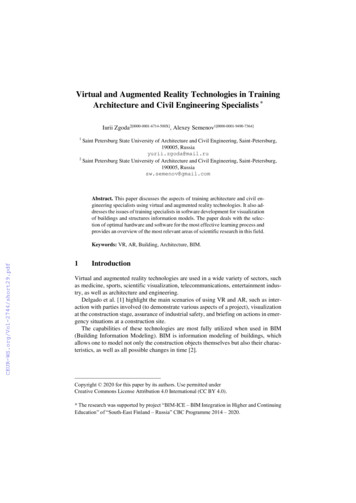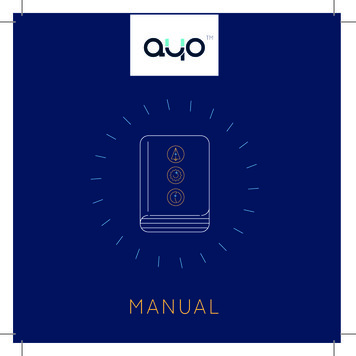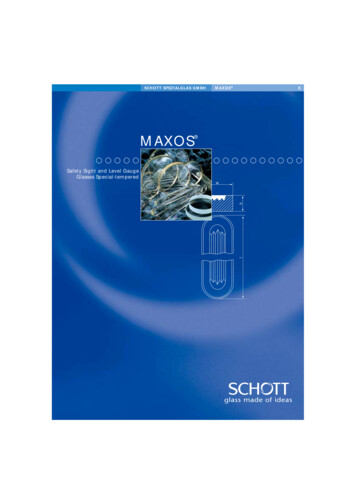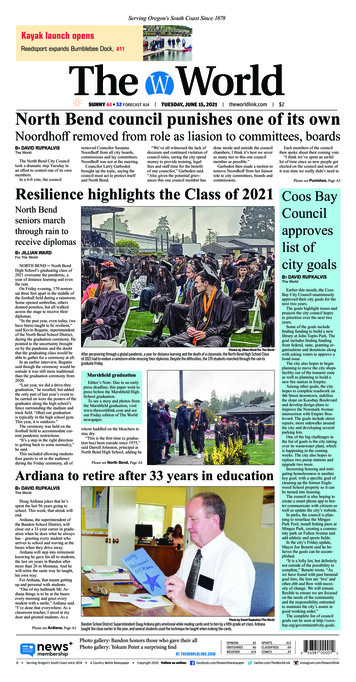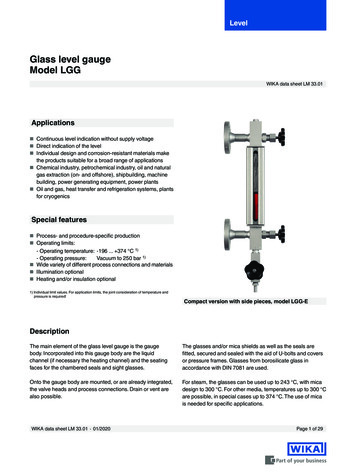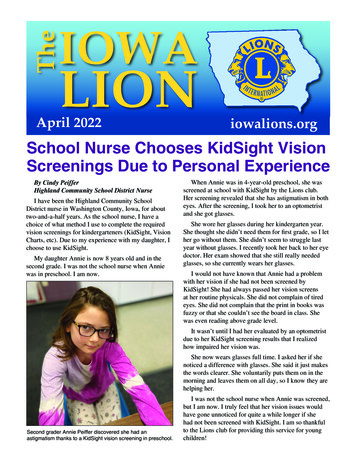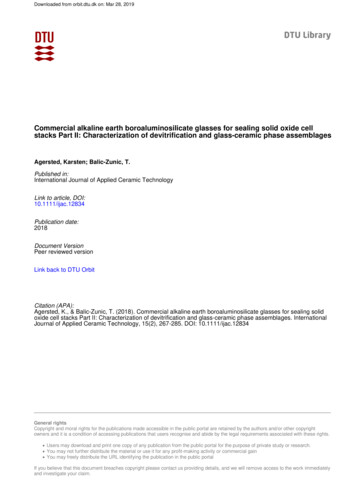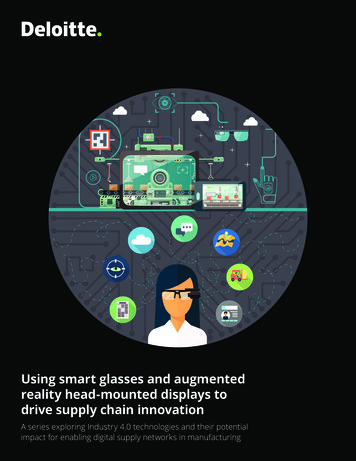
Transcription
Using smart glasses and augmentedreality head-mounted displays todrive supply chain innovationA series exploring Industry 4.0 technologies and their potentialimpact for enabling digital supply networks in manufacturing
Using smart glasses and augmented reality head-mounted displays to drive supply chain innovationContentsWhat are smart glasses and augmented reality HMDs? 4Benefits of smart glasses and AR in the supply chain 6Criteria for evaluation and adoption 8Key applications for smart glasses in your supply chain 10Getting started with smart glasses and augmented reality devices 11Key Deloitte contacts in smart glasses and augmented reality 1202
Using smart glasses and augmented reality head-mounted displays to drive supply chain innovationDo you need smart glasses in your supply chain?Smart glasses are already being used to improve quality,standardize workflows, accelerate decision making, andenhance communication in logistics, manufacturing, andmaintenance operations throughout the supply chain.Of interest because: A trend in more universal,data-driven decision making is evolving just as leaps inhardware and software capability have led to smaller,more ergonomic devices.Could improve your supply chain by: Boosting laboreffectiveness and productivity; reducing quality defects andrework; improving workflow standardization; enhancingworkforce collaboration; improving safety.Why not? The technology is still rapidly evolving and hasnot yet reached operational maturity. Companies will haveto understand how they will leverage data for critical usecases and should expect difficult integration challenges.Deloitte recommends: Evaluate the business case forsmart glasses and augmented reality in your supply chainand pilot on a small number of critical use cases.03
Using smart glasses and augmented reality head-mounted displays to drive supply chain innovationWhat are smart glasses andaugmented reality HMDs?OverviewSmart glasses and augmented or mixedreality head-mounted displays (HMDs) arewearable electronic devices that interfacebetween humans and computing throughvarious forms of a heads-up display. Smartglasses typically have multiple features toallow users to both display and analyzeinformation relevant to their surroundings.With augmented or mixed reality, digitalprojections are overlaid onto real lifeobjects, providing contextual informationand allowing users to visually manipulatetheir surroundings. Today, augmented realityis possible through smartphones, tablets,and a host of other mediums; this paper willfocus specifically on head-mounted displaysand their impact on supply chains.4Recent developments and outlookSmart glass technology has evolvedsignificantly over the last five years. Today’sdevices are less intrusive, more ergonomic,and faster than their predecessors.Emerging from the initial lackluster receptionthese devices faced in the consumer setting,the capabilities enabled by smart glasssolutions are poised to drive real value inenterprise environments. This enterprisemovement will likely unfold over the nextdecade as smart glasses and augmentedreality HMDs continue to improve on theirability to address important commercialuse cases.Smart glass technology is alreadyadvancing in hands-on industries suchas manufacturing, logistics, field services,inspection, and operations. A recentstudy showed that 93% of large industrialcompanies are either using or evaluatingsmart glasses in their enterprises today,indicating that decision-makers foreseewearables as a major enterprise platform.1Product-specific attributes such as aneasy-to-use design, improved ergonomics,and portability have improved the generalusability of the devices and decreasedenvironmental safety risks. These changesare playing out in the market today:Alphabet recently relaunched GoogleGlass, eschewing the consumer market forserious enterprise customers. And manyhardware manufacturers are incorporating
Using smart glasses and augmented reality head-mounted displays to drive supply chain innovationaugmented reality into safety glassesor existing industrial equipment. Thetechnology is improving at a rapid pace—battery life has been extended, visuallatency continues to drop, and many devicescan now even accommodate prescriptionlenses—and the technology hype is startingto turn into reality. Companies are startingto pilot the technology, selecting smartglasses that have high-performing hardware,a simple and intuitive interface, easyintegration, and an ecosystem of servicesand accessories.Forrester predicts over 14 million workerswill use smart glasses by 2025. Enterprisespending on smart glasses, 6 million in2016, is expected to reach as high as 4.3 billion in 2022.2 Technology costand barriers to adoption will continue todecrease as this market continues to grow,and it will likely be driven by increasedenterprise use in the supply chain andoperations functions.Smart glasses in the supply chainSmart glasses and augmented realitydevices have the potential to enhance andeven replace existing technology solutionswithin enterprise supply chains, and insome cases even change the very structureof the work environment. Companiesimplementing augmented reality HMD pilotsare already demonstrating use cases thatlead to increases in workplace efficiency,productivity, and compliance, and this willonly grow as the technology matures. Initialimplementation will be driven throughthe logistics, maintenance, and assemblyfunctions, but as the devices gain moremainstream adoption, companies will bemore comfortable experimenting with thetechnology in different environments.OverviewValuedrivers Contextualized information Increased workflowstandardization Enhanced training andcommunication Hands-free assistance Visual documentation andenhanced process tracking Greater employeeengagementScopeEnhanced capabilitieswithin all segments of thesupply chainTechnology Smartphones, tablets,substitutes PCs, handheld scanners,manuals, VR devicesFive key developments in smart glasses and augmented realityIoT infrastructureBattery lifeCost reductionsImprovements in hardware form factors and ergonomicsParallel advancements in VR5
Using smart glasses and augmented reality head-mounted displays to drive supply chain innovationBenefits of smart glassesand AR in the supply chainPrimary potential benefitsIncrease productivitythrough real-time,contextualized workflowsReduce qualitydefects and reworkFacilitate informed,real-time decision-makingEnhance workforcecollaborationImprove safety throughstandardizationSecondary potential benefits(intangibles) of smart glasses Simplify routine workflow itemssuch as picklists and checklists Decrease risk in industrialoperations Enhance effectiveness of trainingprograms with the use of interactiveand virtual sessions Capture workflow analytics toidentify process improvementopportunities Increase accountability throughinspection workflow recording6Value drivers for smart glassesWhen used effectively in the right setting,smart glasses and AR displays have anumber of important advantages overcomputers, tablets, and other existingtechnology: contextualized information,increased workflow standardization, handsfree assistance, and documentation.Smart glasses provide a hands-freeapproach to performing work by providingdata and virtual instructions to workers asthey complete activities. Virtual instructionsare being used to standardize workflows inindustries with seasonal labor changes, suchas ecommerce logistics, and for complex,rapidly changing tasks, such as maintenanceand repair.Through audio and video capabilities,workers can interact with other colleaguesand seek assistance on complex issuesfrom experts within their organizationanywhere on the globe. Such productivitygains improve the cost-effectiveness ofsupply chain operations, expedite issuetroubleshooting, and reduce the number ofquality errors. While performing complextasks, workers can summon interactiveon-demand training videos, which overlayaugmented reality on their environment.This is especially critical in industries thatface an aging workforce where significantinstitutional knowledge is disappearingrapidly. Companies are starting to mitigatethe risks of industry transition and
Using smart glasses and augmented reality head-mounted displays to drive supply chain innovationinstitutionalize knowledge by facilitatingstandardization and learning through thedevices to increase speed to proficiency.Furthermore, archived videos capturedwhile performing job duties can be usedas evidence during inspections to improvestandardization and prove regulated stepswere followed. Companies are starting touse these capabilities for end-of-line qualityexaminations where detailed checklists anddocumentation must be completed quickly.Used as a tool to standardize qualityand safety workflows—and provide thisinformation hands-free—smart glassesoffer additional intangible benefits tocompanies that operate in dangerousindustrial environments. Leaders in energy,transportation, utilities, and industrialmanufacturing workplaces will find thedevices’ ability to standardize and documentsafety measures attractive tools forimproving workplace safety.Case study: Semiconductor Manufacturing Co. 3A semiconductor manufacturer facedvarious issues with its incident resolutionprocesses, resulting in severe delaysduring critical component assembly. Aninability to visually communicate issueswith remote experts and cumbersomeprocess manuals were the keycontributors of the issue.The company decided to invest in asmart glass wearables solution to allowsupplier technicians in an Asia-Pacificfacility to communicate real-time withManufacturing & Quality Experts inthe US and EMEA. This implementationresulted in “see what I see” measuresthat significantly altered how thecompany executed troubleshooting oncomplex problems.Observed benefits in the supply chain: Enabled high-quality and reliableoff-shore manufacturing and assemblyby providing the capability to bringreal-time distributed expertise spreadover three continents in a matterof seconds Fifty percent reduction in repair timefor defects and assembly failures Reduced travel costs ( 5,000 /engineer/trip) by more than 500,000 Increased productivity ofremote experts Improved operational efficiencyof component assembly whentechnicians received targetedprocedures in field of viewIn the short term, cheaper devices suchas laptops, smartphones, and tablets willcompete with smart glasses. Organizationsin the hands-on services space still usepaper manuals and handheld electronicdevices to provide workers with theinformation they need, deeming them “goodenough” solutions. However, in the longterm, improved device design, capabilities,and cost will tip the scale for smart glassdevices beyond existing technologies.7
Using smart glasses and augmented reality head-mounted displays to drive supply chain innovationCriteria for evaluationand adoptionOperational considerationsTo adopt smart glasses and augmentedreality HMDs in your supply chain, startby understanding where you will use thetechnology and how it will be adopted byyour employees. The following five attributescan help shape your decisions anddetermine the potential overall return onyour company’s smart glasses investments.Functional deploymentComplex, repeated tasks that benefit fromimprovement in standardization may offerthe best initial deployment of smart glassdevices. Understanding which functions,facilities, and individuals start with thetechnology will be critical to asuccessful rollout.Key considerations in this category: Which functions offer the mostopportunity for standardized workflowsand improved decision making? Where will there be minimal changeto existing workflows and workenvironments? How many devices do you need to achieveexpected benefits? Do you have the right champions in yourtarget functional area to drive adoption?Technology infrastructureSmart glass and augmented reality devicesuccess depends on facilitating interactionwith the right data through integration withcomponents of a company’s IT ecosystem.In doing so, smart glasses can become apart of the workflow rather than a separatetechnology, seamlessly receiving andtransferring data with enterprise systems,software, applications, and external devices.8Key questions to consider: What is the interaction layer for data (whatdata, synthesized in what way) that bestsupports users? What systems are required in thetechnology stack? What connectivity is needed and do youhave it in the desired facilities? What parallel investments do you wantto make (sensors, RFID, network, etc.) toenhance the value of the technology?SecuritySecurity is another major concern andpotential barrier to the adoption of smartglasses. Given the capabilities of smartglasses to record and transmit data easily,companies will need to set restrictions oncertain smart glass capabilities to protecttheir employees and customers.Key considerations in this category: Given increased device-enabledworkflows, what are your mitigationstrategies for a network disruption? Do you want to restrict data capture incertain GPS locations? How strong is your security network tocontain information flow throughthe devices?
Using smart glasses and augmented reality head-mounted displays to drive supply chain innovation Is your mobile device manager softwareequipped for these devices? Will implementation be delayed due tofirewalls, port openings, approvals, anddevice testing?RegulationsIndustry regulation is an existing area ofuncertainty for smart glasses. In manyindustries, devices must comply withOSHA, FCC, UL, ANSI, and other industryspecific requirements. According to theAmerican National Standards Institute,both the physical smart glass frame andthe computing equipment must passperformance standards for equipment wornin the workplace.5Additional considerations in this category: Which countries do you operate in andhow do regulations differ across each? What are the industry requirements forwearable devices in your workplace? What is your plan to handle intellectualproperty flowing globally throughthe devices?Operating environments andperceptionCompanies looking to adopt augmentedreality technology need to understand theiremployees’ experience level with mobiledevices and comfort with technologicalchange. Appropriate trainings andchange management processes can beimplemented to help ease this transitionand drive adoption.Basic considerations in this category: How do you expect the current workforceto respond to working with smart glassesand augmented reality? Are you expecting employees to share thewearable devices with others? How much training is required tofamiliarize employees with the newtechnology?Smart glasses procurement optionsThe technology stackSmart glasses and AR device hardware formjust one aspect of the overall technologystack. As companies look to invest inthe technology, they must consider theother elements required to implementdevices in their operations and whatconfiguration must be done to their existingIT. Understanding the impact of theseelements on overall functionality and costis important to any pilot. Companies mustconsider the cost of things like infrastructureimprovements, additional software andoperating systems, and device replacementrates that may all factor into overall budget.Pricing factorsPrices for augmented reality devicesvary from the low hundreds to 5,000 ormore per user setup, depending on thetechnology and functional capabilities.5, 6The lower end of the spectrum consistsof many simple, eyeglass-like models.Prices increase with improved computingtechnology, better augmented realityinterfaces, and additional features such asintegrated safety equipment, fire-retardantproperties, and bundled handheldscanning devices.When evaluating devices, understand thathardware manufacturers offer differentsetup packages. Some packages will includeonly hardware, while most enterprisesolutions sell the technology as a service,offering an integrated solution that can betailored to a company’s needs. Executiveslooking to implement the technology shouldconsider the implications the purchasingmodel has on capital expenditure budgetsand the technology time horizon.9
Using smart glasses and augmented reality head-mounted displays to drive supply chain innovationKey applications for smartglasses in your supply chainSupply chain applicationsSignificant opportunities for smart glasses exist at each stage of the supply chain.12Develop3PlanExamples1. Develop: Augmented reality visualizationwill benefit both the quality and speedof new product introduction. The abilityto view a new product design in thecontext of its designated environmentwill lead to better designs. And the shiftfrom physical to digital will save R&Dorganizations time and money.2. Plan: Active augmented reality trainingsallow companies to scale the workforcemore rapidly than before in responseto shifting or cyclical demand. This isespecially relevant for seasonal peaks inlogistics and manufacturing.3. Source: Connected glasses with built-insensors will easily scan incoming suppliesduring inspection and relay that data tosuppliers. Hands-free inspection reportsand related images can be submitted andattached to associated packages.4. Make: Smart glasses can display complexwork instructions that are updated astasks are completed to provide real-timeworkflow sign-off. In addition, contextualheads-up checklists that adapt as usersshift locations will increase productivity.104Source5Make5. Deliver: Warehouse “vision picking”systems use smart glasses to guideorder picking, increasing efficiencyin distribution operations. Heads-upinformation displaying package weight,fragility, and associated information willalso improve worker safety.6. Service: See-what-I-see capabilitiesenabled by smart glasses allows servicetechnicians in remote locations tocollaborate with centralized maintenanceexperts and to receive real-time data andinstructions in return.These examples are just a few of the manyopportunities to advance the supply chainwith smart glasses. Opportunities existin the end-to-end supply chain for costreduction and value creation.Motivation for actionThe time for companies to assess theirsupply chains for smart glasses andaugmented reality adoption is now. Leadingcompanies across a host of industries arepiloting and implementing smart glasstechnology within their organizations; theysee the value of this technology within thesupply chain and want to keep pace with thewave of innovation.6DeliverServiceEnterprises with critical use cases for smartglasses and augmented reality that arenot currently exploring this technology willsoon find themselves playing catch-up totheir peers. As the technology continues tomature at a rapid pace, driving down costsand improving technical capabilities, thebusiness case for piloting smart glassesbecomes ever clearer. But, as is the casewith other technological shifts in the supplychain, simply placing it in the organizationis not transformative; the real value comesfrom the process to select, design, apply,and integrate the technology. The approachto deploying smart glasses will be discussedin the final section.Smart glasses add value throughoutthe supply chain: Increased productivity and efficiency Improved quality and accountability Reduced error rates Improved safety Greater employee engagement Enhanced training andcommunication
Using smart glasses and augmented reality head-mounted displays to drive supply chain innovationGetting started with smartglasses and augmentedreality devicesSmart glasses can drive major changes toelements of the supply chain. But, like everymajor change, this technology advancementrequires a strategic approach to begindeploying within a company. Leaders needto understand that piloting this technologymandates a shift in culture towardinnovation, openness, and collaboration. Asuccessful adoption strategy should includefour major points.Follow the business case. First, leadersmust have a clear view of where smartglasses and augmented reality HMDs willdrive the most value in the supply chain—inother words, identify the optimal use case orpossible use cases. This will help make thebusiness case and allow the technology topay for itself in successive implementationsas it is increasingly deployed acrossthe company.Clearly communicate the strategicgoals. Second, supply chain leaders shouldmake sure that the strategy for smart glassesis communicated clearly. Augmented realitycan radically shift employee workflows andprocesses; these shifts may face difficultadoption in some areas of the workforce.Clear communication from leaders of thebenefits and vision for the supply chainare critical, and will ensure confidence asimplementation and other operational risksarise. This will help early adopters apply boldideas and view each failure as a learningopportunity toward future success.Target and pilot. Third, companiesshould pilot the technology in an area ofthe organization where the risk of processchange due to smart glasses is low. Often,this may be the R&D organization, but forother use cases, it may simply be a smallexperimental team in the field. Piloting thetechnology may also mean choices aboutoutsourcing aspects of the technology ratherthan developing it in-house. Careful designand execution on a pilot scale will help provethe technology for greater investment andadoption later.Pick the “champions.” Finally, companiesmust find a small group of employee superusers who can help tailor smart glasses andaugmented reality HMDs to the company’sneeds and will ultimately champion itsfuture rollout. Identify employees who caninfluence the rest of the workforce andhelp them serve as smart glasses and AR“champions.” These people will be eagerto find out about the technology and, inthis way, be in a position to advocate aboutthe benefits and urge their coworkersto participate in training seminars andimplement the technology in their work.11
Using smart glasses and augmented reality head-mounted displays to drive supply chain innovationKey Deloitte contactsin smart glasses andaugmented realityJoseph FitzgeraldPrincipal, Supply Chain &Manufacturing OperationsSupply Chain InnovationDeloitte Consulting LLP 1.415.519.2115josfitzgerald@deloitte.comTony DeMarinisManaging Director, Deloitte DigitalDeloitte Consulting LLP 1.571.814.6703tdemarinis@deloitte.comAllan CookManaging Director,Digital Reality LeadDeloitte Consulting LLP 1.310.400.2060allcook@deloitte.comKellen SmetanaManager, Supply Chain &Manufacturing OperationsDeloitte Consulting LLP 1.248.231.6543ksmetana@deloitte.comThe authors of this paper would like to thank the following contributors:George Pilitsis, Deloitte Risk and Financial Advisory Services LLP; Lynne Calligaro, Deloitte Digital Studios;Brenna Sniderman, Deloitte Insights; Mubeen Khumawala, Deloitte Consulting LLP.12
Endnotes1.Brian Ballard, "The State of Enterprise Wearables," Upskill Report, erprise-wearables/, September 16, 2015.2.J.P. Gownder, et al. "How Enterprise Smart Glasses Will Drive Workforce Enablement,"Forrester, https://www.forrester.com/report/How Enterprise Smart Glasses Will Drive Workforce Enablement/-/E-RES133722, April 21, 2016.3.Deloitte Consulting.4.www.ansi.org.5.Glenn Sanders, "Augmenting the Enterprise with AR Smart Glasses," Greenlight -enterprise-ar-smart-glasses/,November 29, 2017.6.Tim Merel, "The Realty of VR/AR Growth," Tech Crunch, rar-growth/, January 11, 2017.About DeloitteDeloitte refers to one or more of Deloitte Touche Tohmatsu Limited, a UK private company limited by guarantee (“DTTL”), itsnetwork of member firms, and their related entities. DTTL and each of its member firms are legally separate and independententities. DTTL (also referred to as “Deloitte Global”) does not provide services to clients. Please see www.deloitte.com/about fora detailed description of DTTL and its member firms. Please see www.deloitte.com/us/about for a detailed description of thelegal structure of Deloitte LLP and its subsidiaries. Certain services may not be available to attest clients under the rules andregulations of public accounting.This publication contains general information only and Deloitte is not, by means of this publication, rendering accounting,business, financial, investment, legal, tax, or other professional advice or services. This publication is not a substitute for suchprofessional advice or services, nor should it be used as a basis for any decision or action that may affect your business. Beforemaking any decision or taking any action that may affect your business, you should consult a qualified professional advisor.Deloitte shall not be responsible for any loss sustained by any person who relies on this publication.Copyright 2018 Deloitte Development LLC. All rights reserved.
Using smart glasses and augmented reality head-mounted displays to drive supply chain innovation 5 Overview Value drivers Contextualized information Increased workflow standardization Enhanced training and communication
